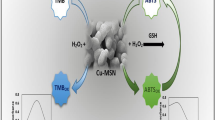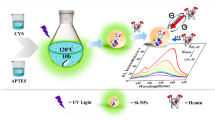Abstract
In our previous study, we have prepared aminated fluorescent silica nanoparticles doped with fluorescein isothiocyanate (FITC) (FSNPs) for the sensing of γ-globulin. Compared with conventional organic dyes, FSNPs show superiorities such as excellent photostability, good water solubility, and biocompatibility, which are in favor of improving the stability and sensitivity of sensors. To extend the application of FSNPs, a convenient and effective method for non-enzyme fluorescent sensor of hydrogen peroxide (H2O2) is introduced based on the synchronous fluorescence technique. The sensor includes two-step reactions, typical redox reaction between KI and H2O2 and iodination reaction between I2 produced by the first step reaction and FITC doped in the network of silica nanoparticles, which induce the fluorescence quenching of FSNPs. The results show that the fluorescence signal of FSNPs linearly decreases with the trace amounts of hydrogen peroxide added in the range 5–80 μM with a detection limit of 0.8 μM under the optimal experimental conditions. The method is simple and sensitive and can be applied to the determination of trace amounts of H2O2. Good recovery data were obtained for the assay of H2O2 in river water by standard addition method with high accuracy and reliability.



Similar content being viewed by others
References
Chai XS, Hou QX, Luo Q, Zhu JY (2004) Rapid determination of hydrogen peroxide in the wood pulp bleaching streams by a dual-wavelength spectroscopic method. Anal Chim Acta 507:281
Pazdzioch-Czochra M, Widenska A (2002) Spectrofluorimetric determination of hydrogen peroxide scavenging activity. Anal Chim Acta 452:177
He F, Tang YL, Yu MH, Wang S, Li YL, Zhu DB (2006) Fluorescence-amplifying detection of hydrogen peroxide with cationic conjugated polymers, and its application to glucose sensing. Adv Funct Mater 16:91
Chen XL, Zou JL (2007) Application of rhodamine B hydrazide as a new fluorogenic indicator in the highly sensitive determination of hydrogen peroxide and glucose based on the catalytic effect of iron(III)-tetrasulfonato-phthalocyanine. Microchim Acta 157:133
Harms D, Luftmann H, Mueller F, Krebs B, Karst U (2002) Selective determination of hydrogen peroxide by adduct formation with a dinuclear iron(III) complex and flow injection analysis tandem mass spectrometry. Analyst 127:1410
Zhou MJ, Diwu ZJ, Panchuk-Voloshina N, Haugland RP (1997) A stable nonfluorescent derivative of resorufin for the fluorometric determination of trace hydrogen peroxide: applications in detecting the activity of phagocyte NADPH oxidase and other oxidases. Anal Biochem 253:162
Hu YF, Zhang ZJ, Yang CY (2007) The determination of hydrogen peroxide generated from cigarette smoke with an ultrasensitive and highly selective chemiluminescence method. Anal Chim Acta 601:95
Choi MF (2004) Progress in enzyme-based biosensors using optical transducers. Microchim Acta 148:107
Lei W, Duerkop A, Wu M, Wolfbeis OS (2003) Determination of hydrogen peroxide in river water using a europium tetracycline microplate luminescence assay with time-resolved (“gated”) detection. Microchim Acta 143:269
Dürkop A, Wolfbeis OS (2005) Nonenzymatic direct assay of hydrogen peroxide at neutral pH using the Eu3Tc fluorescent probe. J Fluorescence 15:755
Chen SH, Yuan R, Chai YQ, Zhang LY, Wang N, Li XL (2007) Amperometric third-generation hydrogen peroxide biosensor based on the immobilization of hemoglobin on multiwall carbon nanotubes and gold colloidal nanoparticles. Biosen Bioelectro 22:1268
Fahnrich KA, Prawda M, Guilbault GG (2001) Recent applications of electrogenerated chemiluminescence in chemical analysis. Talanta 54:531
Sakuragawa A, Taniai T, Okutani T (1998) Fluorometric determination of microamounts of hydrogen peroxide with an immobilized enzyme prepared by coupling horseradish peroxidase to chitosan beads. Anal Chim Acta 374:191
Chen LH, Liu LZ, Shen HX (2003) Mn(II)-sodium dodecyl sulphate complex mimic enzyme-catalyzed fluorescence quenching of Pyronine B by hydrogen peroxide. Anal Chim Acta 480:143
He XX, Duan JH, Wang KM, Tan WH, Lin X, He CM (2004) A novel fluorescent label based on organic dye-doped silica nanoparticles for hepg liver cancer cell recognition. J Nanosci Nanotech 4:585
Wang LY, Zhou YY, Wang L, Zhu CQ, Li YX, Gao F (2002) Synchronous fluorescence determination of protein with functionalized nanoparticles of CdS as a fluorescence probe. Anal Chim Acta 466:87
Gao F, Luo FB, Tang LJ, Dai L, Wang L (2008) Preparation of a novel fluorescence probe of terbium-europium co-luminescence composite nanoparticles and its application in the determination of proteins. J Lumin 128:462
Gao F, Luo F B, Yin J, Wang L(2008) Preparation of aminated core-shell fluorescent nanoparticles and its application to the synchronous fluorescence determination of g-globulin. Lumin (in press)
Hou XL, Tong XF, Dong WJ, Dong C, Shuang SM (2007) Synchronous fluorescence determination of human serum albumin with methyl blue as a fluorescence probe. Spectrochimica Acta Part A 66:552
Wang L, Tan WH (2006) Multicolor FRET silica nanoparticles by single wavelength excitation. Nano Lett 6:84
Santra S, Zhang P, Wang KM, Tapec R, Tan WH (2001) Conjugation of biomolecules with luminophore-doped silica nanoparticles for photostable biomarkers. Anal Chem 73:4988
Finkel NH, Lou X, Wang C, He L (2004) Barcoding the microworld. Anal Chem 76:352
Wang L, Wang KM, Santra S, Zhao X, Hilliard LR, Smith JE, Wu Y, Tan WH (2006) Watching silica nanoparticles glow in the biological world. Anal Chem 78:646
Jain TK, Roy I, De TK, Maitra A (1998) Nanometer silica particles encapsulating active compounds: a novel ceramic drug carrier. J Am Chem Soc 120:11092
Tan WH, Wang KM, He XX, Zhao XJ, Drake T, Wang L, Bagwe RP (2004) Bionanotechnology based on silica nanoparticles. Med Res Rev 24:621
Wang L, Yang CY, Tan WH (2005) Dual-luminophore-doped silica nanoparticles for multiplexed signaling. Nano Lett 5:37
Kim J, Lee JE, Lee J, Jang Y, Kim S, An K, Yu JH, Hyeon T (2006) Generalized fabrication of multifunctional nanoparticle assemblies on silica spheres. Angew Chem Int Ed 45:4789
Gao F, Tang LJ, Dai L, Wang L (2007) A fluorescence ratiometric nano-pH sensor based on dual-fluorophore-doped silica nanoparticles. Spectrochimica Acta Part A 67:517
Gao F, Wang L, Tang LJ, Zhu CQ (2005) A novel nano-sensor based on rhodamine-β-isothiocyanate-doped silica nanoparticle for pH measurement. Microchimica Acta 152:131
Bagwe RP, Yang CY, Hilliard LR, Tan WH (2004) Optimization of dye-doped silica nanoparticles prepared using a reverse microemulsion method. Langmuir 20:8336
Xu JG, Wang ZB (2006) Fluorimetry (third edition). Science, Beijing, p 138
Acknowledgements
The authors are grateful for the financial support from the Natural Science Foundation of China (20705001, 20575001), the Key Project of Educational Committee of Anhui Province (KJ2007A008), the Innovation Group Project of Anhui Normal University and Startup Foundation for PhD of Anhui Normal University.
Author information
Authors and Affiliations
Corresponding author
Rights and permissions
About this article
Cite this article
Luo, F., Yin, J., Gao, F. et al. A non-enzyme hydrogen peroxide sensor based on core/shell silica nanoparticles using synchronous fluorescence spectroscopy. Microchim Acta 165, 23–28 (2009). https://doi.org/10.1007/s00604-008-0091-5
Received:
Accepted:
Published:
Issue Date:
DOI: https://doi.org/10.1007/s00604-008-0091-5




